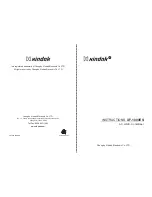
Generator differential protection GENPDIF function uses two mutually independent
characteristics to which magnitudes of the three fundamental frequency RMS
differential currents are compared at each execution of the differential protection
function. These two characteristics divide, each of them independently, the operate
current – restrain current plane into two regions: the operate (trip) region and the
restrain (block) region, as shown in figure
. Two kinds of protection are obtained:
•
the non-stabilized (instantaneous unrestrained) differential protection
•
the stabilized differential protection
The non-stabilized (instantaneous) differential protection is used for very high
differential currents, where it must be beyond any doubt, that the fault is internal. This
limit, (defined by the setting
UnrestrainedLimit
), is a constant, not proportional
dependent on the bias (restrain) current. No harmonic or any other restrain is applied
to this limit, which is, therefore, called the unrestrained limit. The reset ratio of the
unrestrained characteristic is equal to 0.95.
The stabilized differential protection applies a differential (operate) current, and the
common bias (restrain) current, on the operate-restrain characteristic, as shown in
figure
. Here, the actual limit, where the protection can operate, is dependent on the
bias (restrain) current. The operate value, is stabilized by the bias current. This operate
– restrain characteristic is represented by a double-slope, double-breakpoint
characteristic. The restrained characteristic is determined by the following 5 settings:
•
IdMin
(Sensitivity in section 1, set as multiple of generator rated current)
•
EndSection1
(End of section 1, set as multiple of generator rated current)
•
EndSection2
(End of section 2, set as multiple of generator rated current)
•
SlopeSection2
(Slope in section 2 of the characteristic, set in percent)
•
SlopeSection3
(Slope in section 3 of the characteristic, set in percent)
100%
Ioperate
slope
Irestrain
D
= D
×
EQUATION1246 V1 EN
(Equation 27)
Note that both slopes are calculated from the characteristics break
points.
The operate-restrain characteristic is tailor-made, in other words, it can be constructed
by the user. A default operate-restrain characteristic is suggested which gives
acceptably good results in a majority of applications. The operate-restrain
characteristic has in principle three sections with a section-wise proportional
dependence of the operate value to the common restrain (bias) current. The reset ratio
is in all parts of the characteristic equal to 0.95.
Section 1 is the most sensitive part on the characteristic. In section 1, normal currents
flow through the protected circuit and its current transformers, and risk for higher false
differential currents is low. With generators, the only cause of small false differential
1MRK502052-UEN B
Section 6
Differential protection
153
Technical manual
Summary of Contents for Relion REG670
Page 1: ...Relion 670 series Generator protection REG670 2 0 IEC Technical manual ...
Page 2: ......
Page 44: ...38 ...
Page 58: ...52 ...
Page 80: ...74 ...
Page 106: ...100 ...
Page 482: ...476 ...
Page 548: ...542 ...
Page 570: ...564 ...
Page 600: ...594 ...
Page 608: ...602 ...
Page 630: ...624 ...
Page 862: ...856 ...
Page 1094: ...1088 ...
Page 1226: ...1220 ...
Page 1250: ...1244 ...
Page 1297: ...1291 ...












































